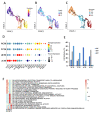Cellular Phenotypic Transformation in Heart Failure Caused by Coronary Heart Disease and Dilated Cardiomyopathy: Delineating at Single-Cell Level
- PMID: 35203611
- PMCID: PMC8962334
- DOI: 10.3390/biomedicines10020402
Cellular Phenotypic Transformation in Heart Failure Caused by Coronary Heart Disease and Dilated Cardiomyopathy: Delineating at Single-Cell Level
Abstract
Heart failure (HF) is known as the final manifestation of cardiovascular diseases. Although cellular heterogeneity of the heart is well understood, the phenotypic transformation of cardiac cells in progress of HF remains obscure. This study aimed to analyze phenotypic transformation of cardiac cells in HF through human single-cell RNA transcriptome profile. Here, phenotypic transformation of cardiomyocytes (CMs), endothelial cells (ECs), and fibroblasts was identified by data analysis and animal experiments. Abnormal myosin subunits including the decrease in Myosin Heavy Chain 6, Myosin Light Chain 7 and the increase in Myosin Heavy Chain 7 were found in CMs. Two disease phenotypes of ECs named inflammatory ECs and muscularized ECs were identified. In addition, myofibroblast was increased in HF and highly associated with abnormal extracellular matrix. Our study proposed an integrated map of phenotypic transformation of cardiac cells and highlighted the intercellular communication in HF. This detailed definition of cellular transformation will facilitate cell-based mapping of novel interventional targets for the treatment of HF.
Keywords: cardiac fibrosis; coronary heart disease; heart failure; myosin; phenotypic transformation; single-cell RNA sequencing.
Conflict of interest statement
The authors declare no conflict of interest.
Figures







References
-
- Wang L., Yu P., Zhou B., Song J., Li Z., Zhang M., Guo G., Wang Y., Chen X., Han L., et al. Single-cell reconstruction of the adult human heart during heart failure and recovery reveals the cellular landscape underlying cardiac function. Nat. Cell Biol. 2020;22:108–119. doi: 10.1038/s41556-019-0446-7. - DOI - PubMed
-
- Tyser R.C.V., Ibarra-Soria X., McDole K., Jayaram S.A., Godwin J., Brand T.A.H. van D.; Miranda, A.M.A.; Scialdone, A.; Keller, P.J.; Marioni, J.C.; et al. Characterization of a common progenitor pool of the epicardium and myocardium. Science. 2021;371:371. doi: 10.1126/science.abb2986. - DOI - PMC - PubMed
LinkOut - more resources
Full Text Sources
Research Materials
Miscellaneous

